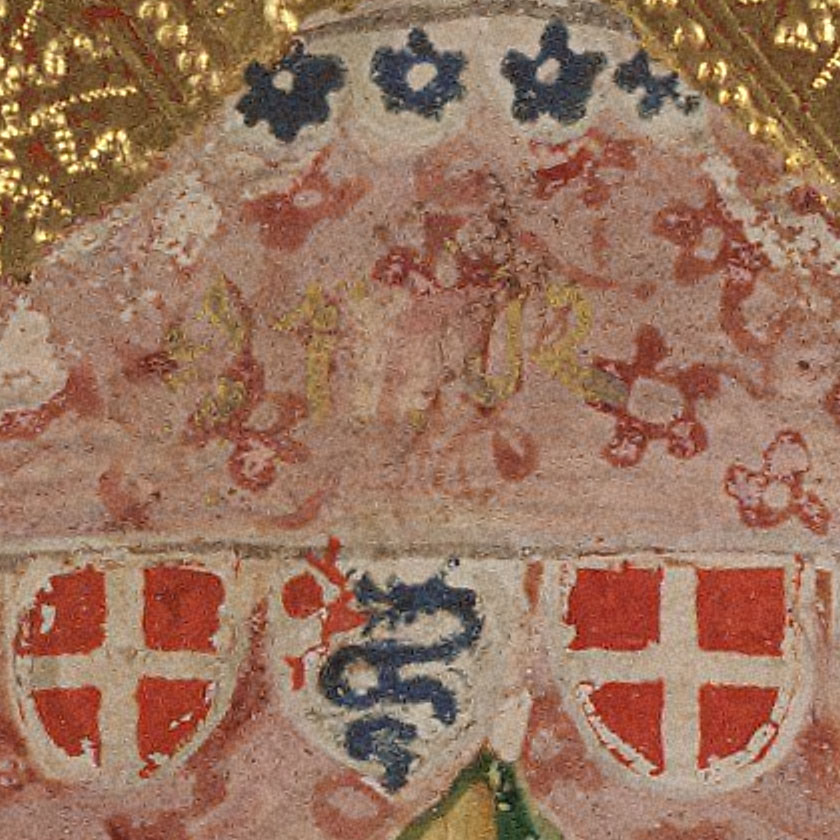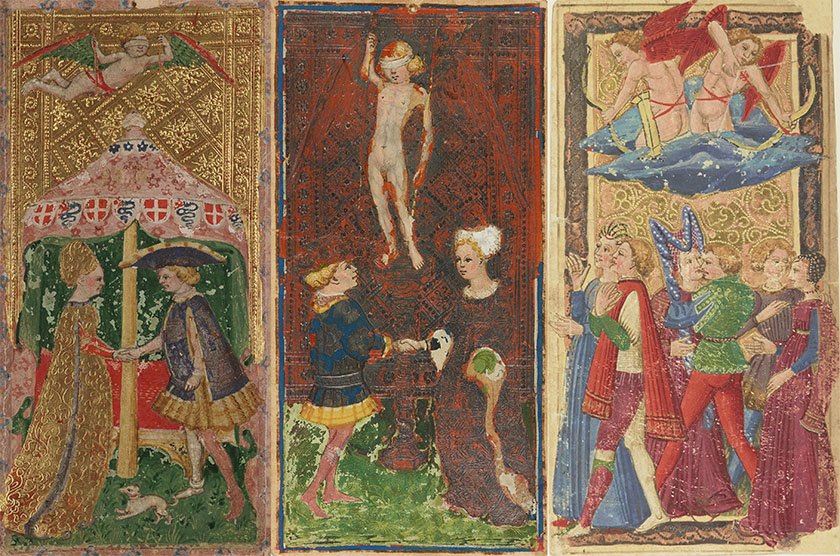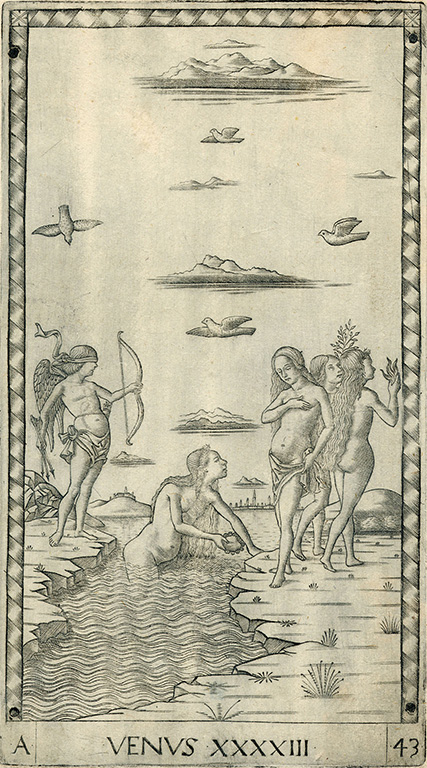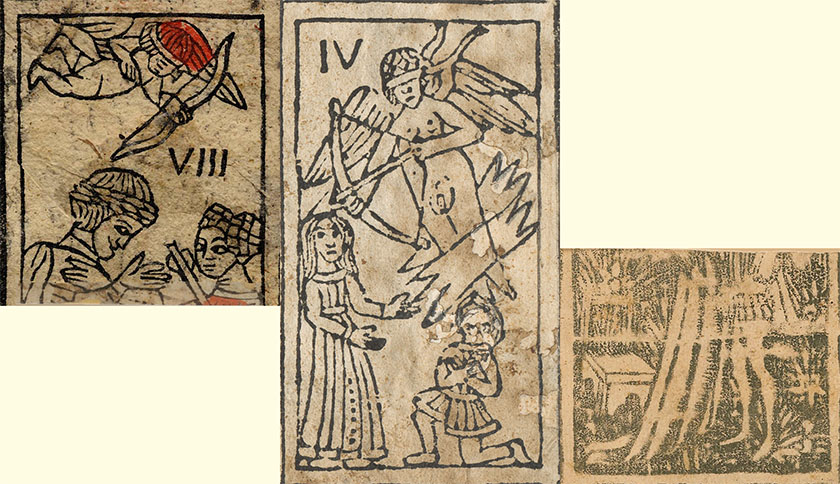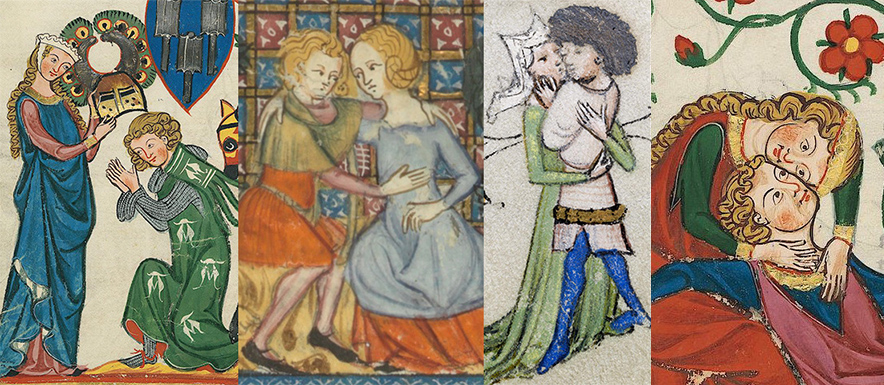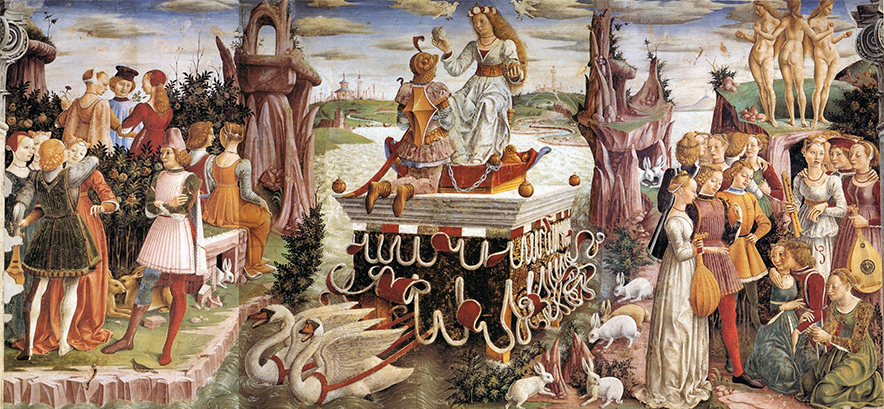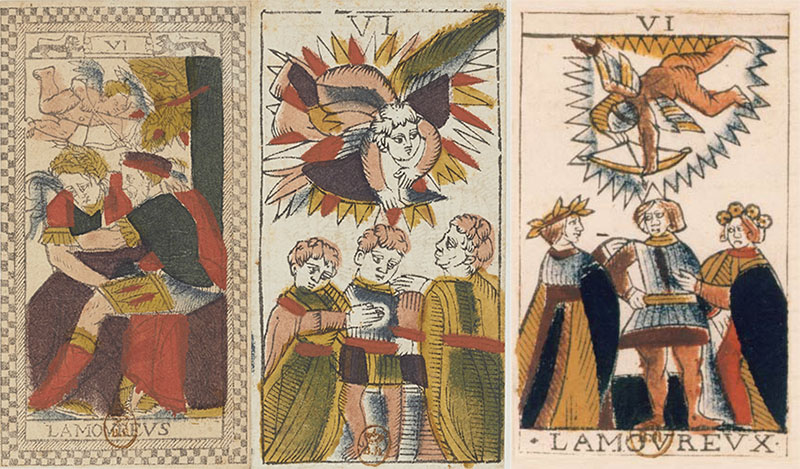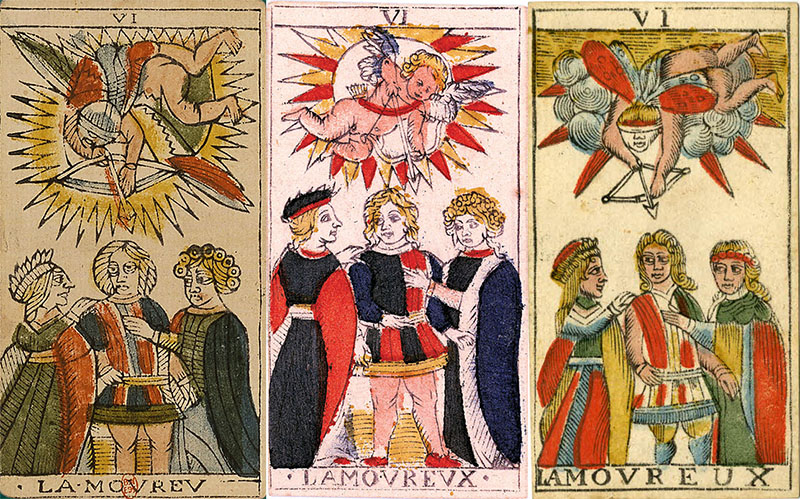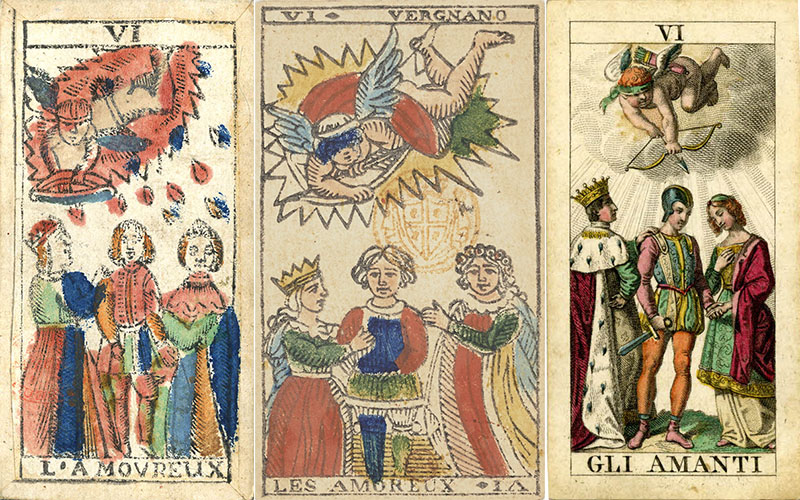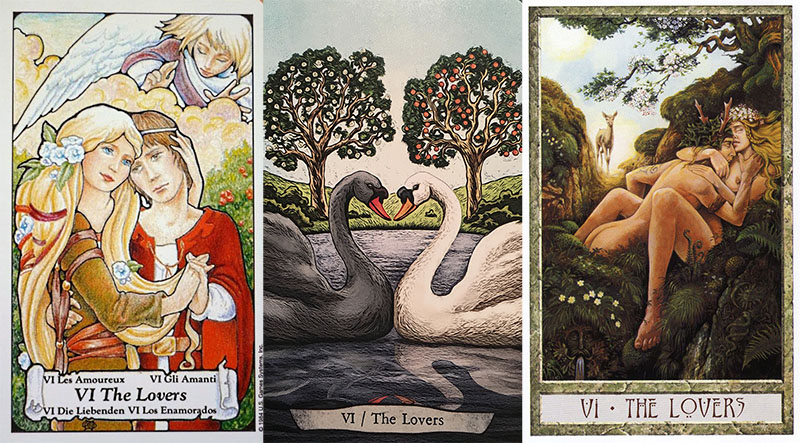THE TAROT WHEEL
L'AMORE - LOVE
A detail of an umbrella with in golden characters the word Amor written on it. This is a Latin word that means Amore in Italian or Love in English. The characters have partially disappeared, but their traces are still clearly visible. On the sides of the umbrella we see the alternating shields of the Duke of Milan and the Duke of Savoy. An umbrella is a protective device, why do we find it on a Trionfi deck and why does it have the word Love written on it? The card presenting this umbrella is from the Visconti di Modrone or Cary Yale Visconti Tarot, a deck created in 1442 for the marriage between Bianca Maria Visconti and Francesco Sforza.
The card nowadays called the Lovers did survive on three handpainted Trionfi cards. In Italy in the 15th Century this card was called Amore, Love. The first card is from the Visconti di Modrone deck, commissioned in 1442 by the Duke of Milan Filippo Maria Visconti. The second card is from the Visconti Sforza deck, commissioned in 1454 by next Duke of Milan Francesco Sforza and the last card is from the so called Charles VI deck, probably commissioned somewhere between 1460 and 1465 from Florentine painters by the Estensi court from Ferrara. In contrary to the Milanese decks there are no heraldic or other symbols on the card that can help identifying the persons. The images on the Milanese decks are so similar in style, that they are are supposed to be painted by the same painter, according experts Bonifacio Bembo.
On the first card we see two people, a woman and a man, shaking hands. They are standing under an umbrella decorated with the shields of the Duchy of Milan and the Duchy of Savoy. On the umbrella is written the word Amor. Above the umbrella is flying a blindfolded angel boy, representing the God of Desire, Cupid. He has the body of a toddler and in his hand he is holding a bow and an arrow. On the ground between the two people a small frisky dog. The golden dress of the lady is decorated with many blossoms, a symbol probably used to designate Bianca Maria Visconti. The man is wearing a blue tunic decored with a hexagonal double fountain. This fountain represents the Fountain of Life, one of the symbols for the Sforza family. The two people on the card can be identified as Bianca Maria Visconti and Francesco Sforza. Their handshake represents the conclusion of a deal, a marriage to be precisely. The small dog between them symbolizes fidelity, they promise to stay forever together. An umbrella symbolizes protection. The shields of Milan and Savoy indicate that the marriage stands under the protection of Filippo Maria Visconti, Duke of Milan and his wife Marie de Savoy. The arrow in the hand of Cupid is the much feared Arrow of Love. But Cupid is inactive and he does not try to shoot his arrow. He can do nothing for this noble couple. Desire is not a motif for their marriage, a marriage that is concluded only for strategical benefits.
The second card looks a lot like the first one. On the dress of the Lady many wavy and radiating suns, symbol of the Visconti family. On the blue tunic of the man there are just some radiating suns. It is clearly the same couple, Francesco Sforza and Bianca Maria Visconti. We are twelve years later, and Cupid in not a toddler any more. He has grown out into a young and handsome boy. He is not flying neither but standing on a pedestal. He is still blindfolded and inactive with in his hand his weapons of Love. The handshake of the couple confirms the stability of the marriage that continues without any intervention of Cupid.
On the third card several noble couples are parading under a shower of Arrows of Love, shot at them by two winged boy angels. Contrary to the Cupid figures in the Milanese deck, the boy angels on the Ferrarese (Fiorentine) deck are not blindfolded. We cannot say who is who, but at the Estensi Palace their are several young man in the age to get married (Ercole born in 1431, his brother Sigismondo, born in 1433, their half-brother Rinaldo, born in 1435. All these boys were sons of Niccolo III, the late Marquis of Ferrara and half brother of Borse d'Este, the actual Marquis of Ferrara and Duke of Modena and Reggio). This card is clearly a message for them to get married and to have children.
These images of "Love" are a testimony of the fact that every single handpainted Trionfi deck was a singular one with its specific story. Every "Love" card in each of these decks, while using the same theme (a man and a woman and the Cupid above them), was executed with a specific story behind these cards. Here we are far from the standarization imposed by the printed decks. Note that both Greek and Roman mythology had two Gods of Love. We have the Greek God Eros and his Roman counterpart Amor, Gods of Love (affection or love from Soul to Soul). But we also have the Greek God Himeros and his Roman counterpart Cupid, Gods of sexual desire (lust or love from body to body). Himeros and Cupid are often depicted as boys, like on the Visconti decks, there where Eros and Amor are in general young mne, like on the Estensi deck. The allegory most used in the Tarot is Cupid, love as physical desire.
In the Mantegna print, not a Tarot card, not made by Mantegna and not even a playing card but a print, we see Venus bathing. She is looking at the three Graces and behind her is standing her son Cupid, blindfolded as usual. Four doves are flying in the sky. Venus is using a scallop shell to take water to wash herself. In the Roman tradition it was said that Venus was born from a sea shell. Sandro Boticelli represented a giant scallop shell, when he painted around 1485 his famous painting, the Birth of Venus.
This Mantegna print is not a picture in the tradition of the Tarot, but it is shown as an example of a contemporary print dating from 1465 dealing with the same subject, love. Here this print is depicting Venus, the Roman Goddess of Love. The three Graces and Cupid were symbols of love, very much used on art works dating from that time. The birds in the sky are clearly doves, often used as a symbol of peace and love. In contrary, in the 1470 version of the Mantegna print, the birds represented are ducks, of which the symbolism is less clear.
The uncut sheets of Tarot cards that have been found back in the bindings of old books are in most cases fragments. Only the Rosenwald sheet show us the full sheet image, and thus the whole card. From left to right we have a fragment of the Lovers card of the Budapest sheets, the Rosenwald sheet and the Cary sheet. Three sheets in the style of the Budapest sheet conserve the upper part of the Lovers card. Two of these sheets are conserved in the Budapest Museum of Fine arts and one is conserved in the Metropolitan Museum of Art in New York. The Rosenwald sheet is conserved in the National Gallery of Art in Washington D.C. and the Cary sheet can be found in the Beinecke Rare Book & Manuscript Library of the Yale University in New Haven.
On the Budapest sheet we see a man and a woman. It looks like the man has declared his love to the woman. Cupid stays an important symbol on the Lovers card. He has taken profit of the situation and one of his arrows is planted directly in the heart of the woman who is squinting a bit. On the Rosenwald sheet we are at the moment that a man is declaring his love to a young lady.. Cupid did not send yet his arrow, but he is ready to do so. Also here it seems that he is ready to shoot his arrow in the heart of the Lady to help her responding positive to the boys's declaration of love. Because we only have the lower half of the Lovers card of the Cary sheet it is difficult to describe the scene. In every case, man and woman are standing very close to each other, what they are doing is mere speculation. Behind the woman a chair, probably she was seated before the man was coming and now they are embrasing each other. Here we are very far from the Visconti cards, these lovers cards clearly represent pure love, there where the Visconti cards reject this kind of love.
Again we have several variations on the same theme as used on the handpainted cards. Two people in love and Cupid helping a bit with his arrows of love. When we take a look at the depiction of Love in Renaissance art, we have the embarrasment of choice. Love is one of the favorite subjects of artists and it can be shown in many different ways. A flying Cupid sending its Love Arrows down to Earth is a symbol often used in Renaissance art to indicate love.
The Cupid at the left is painted by Raphael and the one at the right by Boticelli. The Boticelli Cupid is blindfolded, the one painted by Raphael isn't. Both images post date the earliest Trionfi cards, so let us have a look at some pieces of art that dates from before 1440.
In the Middle ages, most paintings were religious of nature. Love between a man and a woman is expressed in songs and illustrated in manuscripts. Probably the most popular way of expression was courtly love. Courtly love emphasized on knights and noble ladies. It prescribed the rules of conduct between lovers, advocating idealized but illicit love. Especially in literature courtly love was a very popular subject. But this was not the only way, love songs could have other, more down to Earth subjects. Here below four examples of the way of expressing love in the late Middle Ages, all of them from 14th Century manuscripts. The first and the last image are from the early 14th Century Codex Manessa, the second one is from the 1380 Roman de la Rose and the third is from an unidentified manuscript.
In the early Renaissance, the Classic Art is rediscovered, and less and less taboos are existing in the expression of visual Arts (painting and sculpture). Here below a beautiful example of the expression of love in such a painting dating to the early Renaissance, a fresco ordered by Borso d'Este to decorate the Palazzo Schifanoia. The fresco is called the Triumph of Venus and the painter is Francesco del Cossa.
In the middle of the painting a knight declaring his love to a Lady. A typical example of courtly love. The knight would fulfill any wish the Lady would have. His love linking him to the Lady is symbolized by the chain attaching him to her throne. On the left and right sides of the painting many other representations of love, a young man embrasing a girl, another boy kissing a girl, the three Graces, many rabbits expressing fertility, several lutes, the prefered instrument of a minnesinger and many other, too much to cite them all.
Now let us go back to the Tarot cards. How was love represented on the decks after the 15th Century. While we do not have any example from the 16th Century, we jump immediattely to Paris in the 17th Century with the Tarot de Paris and the decks of Jaques Vievil and Jean Noblet.
On the Tarot of Paris we see a (not so young) couple sitting together, behaving like on the picture we have seen from the Roman de la Rose. Like on the Budapest sheets, Cupid is flying above the couple and he is ready to shoot his arrow of love. This time he is pointing at the older man sitting together with his mistress. On the Tarot of Vievil a boy is standing between two ladies. A girl on his right side is looking at the boys's face and putting her hand on the heard of the boy. She is clearly in love with him. The older woman is putting her hand on the boy's shoulder. The boy is looking to the hand of the older woman. He seems a little bit pertubed and has his hand firmly on his belt. It looks like the woman is giving advice to the boy. Maybe the boy and the girl are just married and the older lady is the mother of one of them telling the boy to take good care of her. Cupid flying above has a bow in his right hand, but he has no arrows. He is looking to the right side of the card, to the future. In his toughts he is more concerned by his next target than by the lovers below him. His arrow of love has allready done his job, so he can move on. There is a radiation behind Cupid, but we cannot clearly detect its source. On the card of Jean Noblet, this is much clearer. here it is clearly Cupid who has a shining corona around him, as if he is radiating light or love. On later Tarot de Marseille decks this changed, it is not Cupid anymore who is radiating love, but he is flying in front of the Sun. The card of Jean Noblet has some aditionnal symbols. The young woman has a bridal flower crown, and the older woman has a crown of laurel leaves, the crown of victory. The older woman and the boys are facing each other directly. Now the woman does't seem to give advice anymore, on contrary, it seems that she is trying to seduce the boy. The younger woman looks angry, she is clearly not agreeing with the older woman. For the moment she can be confident, the boy is heading with his right hand (remember that Jean Noblet mirrored the images) to the genital area of the young woman, here love area. But Cupid's arrow is pointed to the boy, what will happen if the arrow hits him? Is Cupid in conspiracy with the older woman or is he helping the younger one?
The card is called Lamoureus on the Tarot de Paris and Lamoureux on the Tarot de Marseille, a name also used by Vievil on the Ace of Coins. Translating" the Lovers to French would give us "Les amoureux", so the spelling used might lead us into another translation. Amoureux (in old French amoureus) is an adjective that translates to "in love", or "being in love". So Lamoureus or Lamoureux should be spelled withan apostrophe, L'amoureux. Jean Noblet and many other card makers drop on most cards the apostrophe, so we have here a word in singular, not in plural. Lamoureux indicates someone being in love, so the right translation of Lamoureux is "the Lover" and not "the Lovers". While the boy is in the center of the card and while the arrow of love is pointing to him, he is clearly the one who is the Lover.
In France the card "Lamoureux" will never change, on all Tarot the Marseille decks and its derivates the picture and its name will stay the same (except for Cupid who isn't radiating any more but flying in front of the Sun). So let us have a look at some Italian decks to see how the picture varies here. The three images are from two Tarocchini decks and from a Minchiate deck, technically no Tarot decks, but belonging to the same family and having their origin in the Bolognese or Fiorentine Tarocci decks, like the Rosenwald and Budapest sheets.
The three decks are from left to right a Standard Tarocchino deck created somewhere in the middle of the 18th Century in Bologna by Antonio de Maria, in the middle the Tarocchino deck created by Giuseppe Mitelli in 1668, also in Bologna, and finally a Fiorentine Minchiate deck created in the 18th Century. The deck of Antonio de Maria is typical for the printed Bolognese Tarocchino decks and coloured using the same technique as the Tarot of Marseille. Both other decks are hand coloured. On all three decks Cupid takes the same important place as on the earlier Tarot decks. On the deck of Giuseppe Mitelle he becomes even the central theme of the card. The Tarocchino decks are named nor numbered. On the Minchiate deck, that has 41 trump cards, the numbering reappears. On the standard Tarocchino deck, like in the Budapest sheet, Cupid is shooting at the female part of the couple. Here Cupid is radiating again like on the deck of Jean Noblet. In the Minchiate deck on the other hand Cupid is fixing the male part of the two figures. The card is very similar to the Rosenwald sheet, that has its origins in the same part of Italy. Only the target changed, now the it is the man who will receive the arrow of love. The woman is placing a crown on the man's had, as if to emphasice the rules in a relation of courtly love. On the Mitelli deck Cupid is alone and he holds a burning apple in his hand, the apple of desire, the apple that caused Adam and Eve to leave Paradise. He invites the reader of the card to accept this dangerous gift.
Except for the Tarocchino and Minchiate decks from Bologna and Florence, all later Italian decks follow the tradition of the Tarot the Marseille. Let us first see three French cards that follow this tradition before returning to the Italian cards.
From left to right we have the Lover from the 1701 Tarot of Jean Dodal, made in Lyon, typical for a Type I TdM decks, the 1736 Tarot of François Chosson, made in Marseille, typical for the Type II TdM decks and the 1746 Tarot of Pierre Isnard, made in Strassbourg, an example of the Tarot of Besançon. We see the difference between the type I and II TdM decks, that is most evident in the figure of Cupid. On the type I deck, Cupis is identical to the representation on the Tarot of Jean Noblet and he is oriented from right to left. On the Type II decks, Cupid is a lot closer to the representation on the Tarot of Jaques Vievil, he isn't blindfolded anymore and he is positioned from left to right. The drawing is much nicer drawn than the little bit rude Type I card. The card of Pierre Isnard has elements of both decks. His drawing style is nice and detailed, as on the Type II TdM, but Cupid is blindfolded and oriented from right to left, like on the type I TdM. The boy stands now inbetween two beautiful girls, he has a difficult choice to make. Cupid is there to complicate his choice.
The three cards above are typical examples of Italian Tarocchi cards. The leftmost card has been made by Francesco Berti in Bologna. According the British Museum, where the deck is conserved (they bought the cards in 1864), the deck dates from the late 17th Century. Other experts, like Stuart Kaplan and Andreas Vitalli date the deck one Century later. The second card has been made in the early 19th Century in Torino by the cardmaker Vergnano. The card is from a Piedmont style deck, typical for Torino and its surroundings. In this period slowly the French titles disappeared and were replaced by Italian ones. Vergnano and some other cardmakers made decks with French titles as well as decks with Italian titles. The rightmost deck is the so called Dellarocca deck, made in the early 19th Century by the famous Milanese cardmaker Gumppenberg. It is definitely the most detailed and sophisticated TdM style deck ever made.
We remark that all three decks follow the Type I characteristics of the drawing, with a blindfolded Cupid oriented from right to left. The type I decks were made in Lyon and its surroundings under the control of the very powerful Lyonees printers guild. This printers guild had influence far beyond the French borders, reason why it is this type of TdM style that expanded to other European countries. Some changes in details have been made. On the two leftmost cards, the laurel crown made place for a real crown. The boy is know looking straight forward, he has the choice between a noble princess and the most beautiful girl in town. On the Dellarocca card, the elder woman made place for a king. Maybe he is giving advice to the young couple. However, the boy is apparently a soldier, he has a helmet on his head ans a sword in his hand. Maybe the king is calling him to duty, so the boy has to choose between duty and love. On the titles of the three cards we see that the spelling has changed, "L'amoureux" (the Lover) for the Berti card, "Les amoureux" (the Lovers) for the Vergnano card and its Italian translation "Gli Amanti" on the Dellarocca card.
Modern Tarot decks are only limited by the imagination of the creator. Love is the central theme and upon this anything can be put in picture. Here we have from left to right three random examples, the tender Hanson Roberts Tarot, the thematic Animal Totem Tarot and the explicit Druidcraft Tarot. Every card fits in its own theme, in its own deck, far away of traditional symbolism.
So here we are at the bottom of my page about the development of the Lovers card through history. It began as a card called Amore, Love, that moralized the young men in noble families to control their desires, to give priority to State interest rather than to personal happyness. Love transformed later into the Lover, a boy that has to make a difficult choice in his life who to marry. In this phase Cupid is there with his arrows of love to complicate his choice. Often it isn't love of someone's character that prevails, but lust, the desire to a beautiful body. The card the Lover was there to warn us, it presented us with a mirror to our Soul, so we could think about our own choice. Finally the Lover was replaced by the Lovers, a couple loving each other from the deepest of their hearts. Modern Lovers cards represent no warning anymore, they are there like a song of love, a stimulant to keep loving your partner.
